! Japanese Ghost Stories !
I will post a different story every day this week, leading up to Halloween. Yes, every day! And I will try to keep each one relatively, or at least comparatively, short. Each tale has been selected to pertain to each day of the week. So when I'm done, you'll also know all of the days of the week in Japanese. And I won't even dwell on it!
So what's today?
月曜日
getsuyoubi
Monday
Briefly: each day of the week ends in two kanji, you (yō) and bi (from hi), 曜, "weekday", and 日, which you may recognise as sun, but in this case means "day". And since you now know sun, then you also should know 月, moon.
So today's folktale is about the moon.
And it's also appropriate that we start out with one of the most famous folktales of Japan, and one of the oldest, as well.
I've explained before, that there are a great many different and confusing ways to classify legends, stories, folktales, and yōkai-type-things. For "ghost stories", I've shifted my focus from yōkai to yūrei, which is not a legendary creature or monster like yōkai, but a ghost, or a story having to do with a human, or something that was once human and became something else, which may or may not be classified as yōkai, but differentiates itself in that manner. So folktales fit in here, too.
Funny thing about Japanese folktales. They are either egregiously long, or disturbingly short. In the short ones, there are many examples of the narrator simply becoming bored with the story and ending it quickly. It is also the result of the modernisation of the longer stories. Some tales are very long because a lot is happening in them (like today's). But also, the most striking example of difference between Japanese and Western ghost stories is in the description. Often, the story goes like this:
It starts out with a recitation of the main character's name, his aliases, his ranking, what ranks he previously held, which provinces he served, which provinces he lived in, the provinces and rank of his servants also in the story, and also one day when he was crossing a bridge... oh and the description of the bridge, if it had been rebuilt and when, who else the storyteller knew who had crossed that bridge or related the story to him, how that friend is doing now... oh yes, and he was on the bridge and he saw a demon! How very strange! The end.
I'm not kidding. 90% of traditional Japanese folktales are exactly like this.
But today's folktale, as I mentioned is old, and comes not from this realm of storytelling, but from the Heian period. And that means that 90% of the story is fluff, describing one's clothes, one's house, the weather, how the capital is, how lovely the capital is that it is that way, how lovely the ladies of the capital are, and the gentlemen as well, and their fine robes, and this they bought and that they bought and blah blah blah.
So what all am I cutting out of the stories? Well, instead I'll tell you what I'm leaving in:
First and foremost, I will tell the bulk of each story the way it was told to me as a child. However, I won't translate and explain all of the flowery bits. Secondly, as just in Western folktales, the stories have a great variety of different tellings and components, I will include parts that are more well-known nationally, or most popularly told, or parts that I have seen in movies, books, games, works of art, all aspects of Japanese culture over the years. So it will include a variety of pictures and information from many different sources of media. Lastly, I'll include bits that may explain a bit of the cultural context, or just parts of the story I found out about later, but found much more interesting or appealing.
And as I've mentioned, today's story is very old and very famous, so there are tons of different versions and re-imaginings of it. Besides, it's relatively easy to find more on it in English, so I wanted to tell the parts I couldn't find anywhere else in English or Japanese, and include a variety of the different cultural symbols and modern-day references it has had. So like I said, the story itself will be shorter than other versions you may find, but will have a bit more (hopefully) interesting notes.
I know I've got a Heian mindset, and have gone on for much too long. But now that I've said everything I want to do with this series, I won't need to reiterate it, and the stories for the rest of the week (and others in the future) will start right away without this sort of a to-do. Thanks for bearing with me. Let's get started!
『竹取物語』
Taketori Monogatari, "The Tale of the Bamboo Cutter", also popularly known as Kaguya-hime, "Princess Kaguya".
昔々・・・
Once upon a time...
There was an old man who was a bamboo cutter.

He and his wife lived in a humble home in a small village.

They were childless, and wished more than anything to have a baby of their own. One night, when the old man was cutting some stalks of bamboo, he looked up to the Moon, which was full and brightly shining. The pale circle reminded him of a little girl's happy face, and he wished upon it that he could have a daughter.
The next night, as he entered the grove, he saw that a single stalk of bamboo had grown overnight in the clearing, and it glowed with a heavenly light. He cut the bamboo open, and inside he found there a tiny girl sleeping, 3 sun long, no larger than his hand. Knowing his prayer had been answered, he took the baby home, and he and his wife cleaned her and dressed her and set to raise her as their own daughter.
After three days, the girl had grown considerably in size, now resembling a toddler. After three months, she was a fully grown young woman, and possessed an unearthly beauty.

A banquet feast was held for her, which lasted for three days. Her face was the loveliest anyone in the village had ever seen or heard about, she was graceful in her movements, and most notably, her hair shone strangely beautiful like the Moon. Because of this, her parents named her Kaguya, which, depending on your old Japanese characters, could mean "Slender and Graceful Shining Bamboo Stalk from Heaven" or "Illuminated Reflection of the Moon's Beauty".
After Kaguya's arrival, more strange occurrences happened around the old bamboo cutter. Every time he returned to the grove where he found her, and cut open a stalk, each shoot would be filled with gold. The old man and his wife became considerably well-off. Soon, news of the fine things they had, and especially of Kaguya's beauty and grace, had spread far and wide. Distinguished suitors came from all over the land to try to court Kaguya. The bamboo cutter wished to protect his beloved daughter, so Kaguya was hidden behind a screen and not allowed to go out. More suitors came to try to get a look at the supposed most beautiful girl in the world.
Soon, the rumours reached the ears of the Emperor himself, and he knew that the sudden wealth and beauty of the bamboo cutter's home, and Kaguya's refusal of all suitors, must be her way of preserving herself for him and him alone. He enlisted many servants to find out more about her, and try to catch a glimpse of her.
The bamboo cutter and his wife were overwhelmed with all of the attention. It was unfair to keep Kaguya locked up, and the bamboo cutter did need to do his work. He went to Kaguya's room one night to speak with her, where he found her looking outside at the full moon, sobbing in earnest. He asked her what was the matter, and Kaguya confessed that she was sorry for all of the trouble she had caused her adoptive parents, as well as a yearning to go out and find where she had come from, which she could no longer do because of all the people who crowded around their home each day.
While he knew that the truth may upset her further, or what it would cost them, the bamboo cutter thew one of Kaguya's silk robes over her head, and smuggled her out to the bamboo grove.
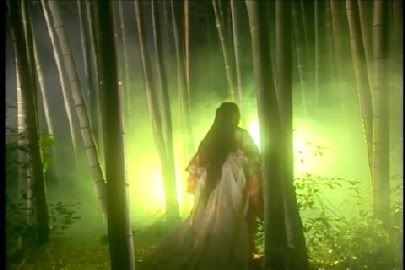
He told her the story of how he had found her. Suddenly, many low clouds formed about the grove, and an otherworldly ship descended. As the door opened, out stepped a number of men and women, dressed beautifully like the highest members of the Heian court, but also with the odd hair that shined like the Moon. They went to Kaguya and embraced her, and explained that they were from Tsuki no Miyako, the Moon Capital, and had come to take her home.
Kaguya did not want to leave her family, but knew that if she continued to stay on Earth, she would cause hardship for them. She gave her father the silken robe he had put over her head, which now shimmered after being touched by the Moon People, and also gifted him with several other treasures from the Moon Court. They shared a tearful goodbye, and Kaguya boarded the space-ship, and returned with her people to the Moon.
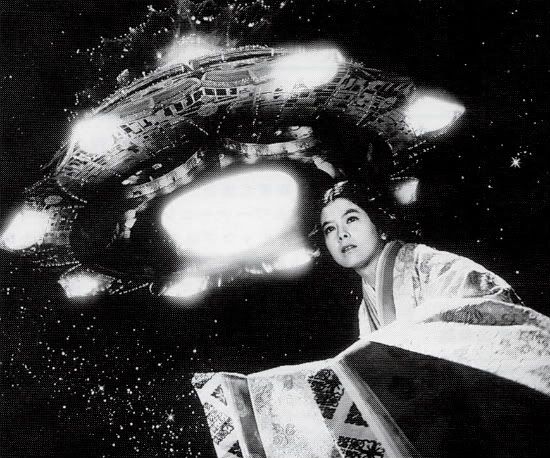
And that's the story as I was told it. Before I go into the rest of the more popular telling, I'd like to talk about the images I've used so far. The live-action pictures are from a film of the tale, and the art is from the video game Ōkami, which follows the story I've told. You can see that Kaguya's outfit involves a space helmet, the ship is made of bamboo, and she seems to have rabbit ears made out of bamboo leaves.

For a more modern take, you may recall Sailor Moon, whose is named Tsukino Usagi, "Moon Rabbit", and has rabbit-ear hair coloured a shiny gold just as Kaguya does... it's loosely based off of the imagery from Kaguya's tale. This is one of the most well-known ones, there are tons of things based off of Taketori Monogatari. Interestingly enough, however, there hasn't really been a major kabuki about Kaguya. Though there has been a Super Kabuki about her. What is a Super Kabuki, you ask? It's a new style of kabuki innovated by an actor, which features all the excesses of apparently everything he could think of. At the same time. On a float.
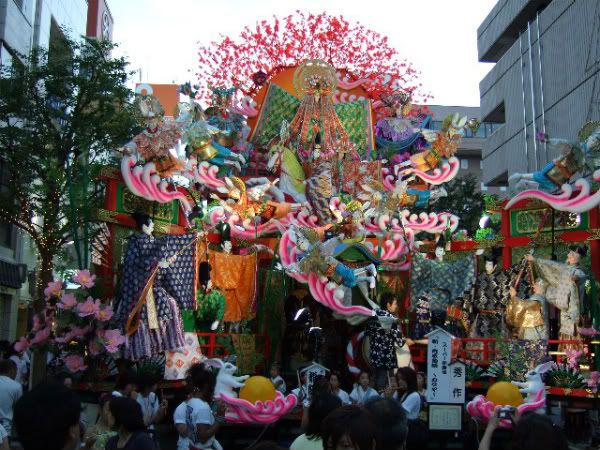
Wow, that's something.
Incedentally, "hair shining like the moon" was only taken to mean blonde in the last fifty or so years. In the Heian period, you'll remember how important lovely hair was, and the shinier it was the better, and apparently Kaguya's was just so shiny and beautiful that it was obvious that she was unearthly. So that's where the hair theme originated. But still, why so many ties between rabbits and the moon? This is because, in Japan, we see a rabbit on the Moon.
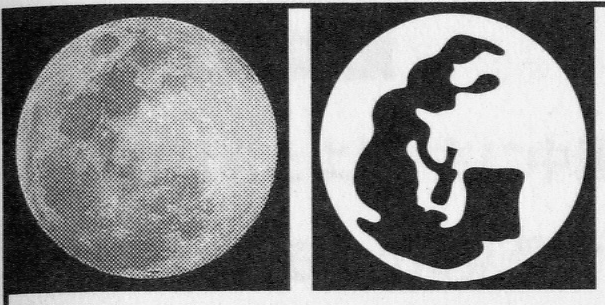
The shadows on the Moon forms a rabbit making mochi. Another interesting bit of information, in Japanese most objects have their own special "counter", the word used after a number to describe what you are counting. There is one for almost everything, and as such, large animals, small animals, and birds each have their own counter as well. However, the counter for rabbit uses, not the small animal counter, but the counter for birds. It goes that monks, who were only allowed to eat fowl, had developed a love for rabbit meat. They argued that rabbit ears were like wings, and when they hopped, only two feet would touch the ground like a bird, and rabbits flew around on the moon as well. So this is why rabbits also get use of the bird counter. It also leads us to the more extended and flowery version of the Kaguya legend, in which she wears a robe of feathers.
The story goes much the same as the one I've just told, up until the suitors arrive. In this version, of course, the suitors are all famous kings or princes of the Heian period, complete with mind-numbingly long descriptions of their life stories, their names, their accomplishments, and depictions of the province each came from. They sit outside of the bamboo cutter's house through the heat of summer and the snow of winter, and demand that the bamboo cutter force Kaguya to choose one of them. The bamboo cutter explains that he will not force Kaguya to do anything, as she is not his real daughter, though he does go to Kaguya to ask her to show pity on the wealthy suitors who gather to see her every day. Kaguya turns them away, though her father explains that such suitors would make an excellent match for her.
Kaguya began to act erratically, and finally decides to give the men a chance. Wary of someone who would only want her as a prize, and prove unfaithful, she tasks each man with a dangerous mission to retrieve an important treasure and bring it back to her. Many of the men disappear, die, or simply wander the earth like vagabonds. The princes, however, each go on a long and heavily described mission in search of a great many fanciful items which vary from telling to telling, including: the thunder from the sky, a flower from paradise, a drum that plays without being touched, the begging-bowl of Buddha, a rainbow jewel from the Sea Dragon's head, a cowrie shell carried across the ocean by a swallow, the fire rat's skin, and a branch from a tree made of silver and jewels.
Incidentally, in the video game Warriors Orochi 2, you need treasures to unlock special upgrades for your character, and each one is titled after one of the gifts Kaguya asked for, and yes, they are often nearly impossible to obtain.
It then goes on for twenty-eight pages. Each mission to get the treasure is long and impossibly flowery, and the princes ultimately fail each time. Perhaps the man who got closest, Prince Kuramochi, FYI, attempted for a while to find the jeweled branch, and eventually arrived at Kaguya's doorstep with the result of his efforts, telling an amazing tale of his journey to Mount Horai, and the excellent forests of jeweled trees he found there.
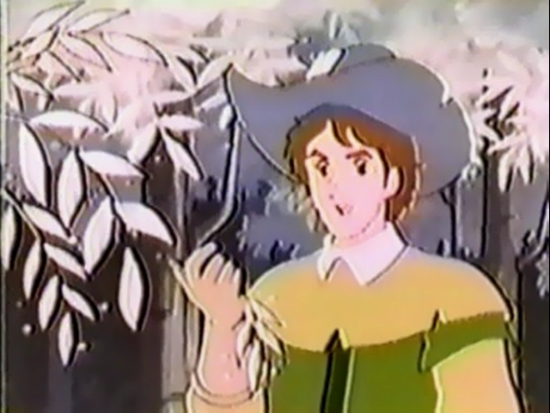
Sorry about the quality of this photo, but in fact I've gotten it from a VHS tape (remember those?) from the 80's that my mother watched, and a decade later I watched as a child.
He presented the jeweled branch to Kaguya, and she was about to consent to marry him until a craftsman arrived and demanded the prince give him payment for the branch of jewels he had fashioned for him. Kaguya herself happily paid the craftsman for his troubles and sent him and prince on their way. Each story of the princes basically goes just like this, with the prince ultimately failing in his efforts or being caught in a lie by Kaguya.
After this ordeal, the Emperor hears of Kaguya's beauty and turning away of men of the highest calibre, save for himself, and realises that she must be waiting for him, and he wants to have her. He enlists his maidservant to go to their home and ask the bamboo cutter to bring Kaguya to the palace, where a high-ranking position in the Royal Court would be waiting for him at their arrival.
The bamboo cutter went to Kaguya once more and told her of her newest suitor. How could she refuse the Emperor as a husband? Kaguya began to shriek and tug at her hair, and dissolved into sobs. "I cannot marry him! I am not from here! I have to leave and go back to my people!" she cried. Terrified for his daughter's well-being, the bamboo cutter set out for the Capital and humbly told the Emperor of his daughter's refusal. Upon returning home, Kaguya's ladies-in-waiting told him that Kaguya had spent all his time away in her room, staring at the Moon each night and crying to herself.
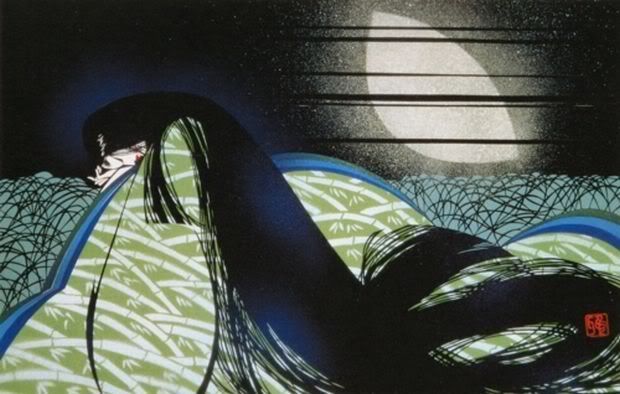
He went in to see her. "I meant what I said." she told him, "I am really from a place far away from here, the Capital of the Moon. And soon my people will come and take me home." The bamboo cutter let it be known that Kaguya was leaving to return to the Moon, and would take no more suitors.
The Emperor, hearing of this, organised a Royal Hunt which brought him to the bamboo cutter's house. He questioned the old man on the rumours he had been told, and the bamboo cutter said that they were true, the people from the Moon Capital were coming to take Kaguya. The Emperor arranged for many guards and soldiers to be positioned around the bamboo cutter's house, for he would not let Kaguya be taken away. The night of the next full moon, however, a strange cloud bearing a space-ship descended from above, right outside Kaguya's window, and they called to her.
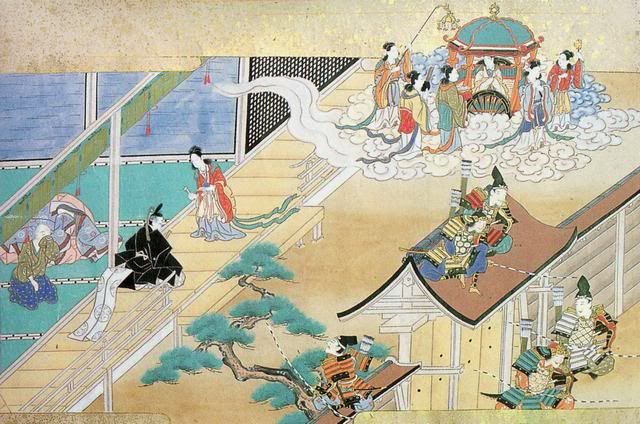
"Young Princess! Come home with us. You mustn't stay in such a poor place!" Kaguya's father begged them to let her stay with him, and the Emperor had his guards shoot arrows at the space-ship, but they all bounced away soon after they were shot, and did not come close to the strange cloud the Moon People stood on. They used their powers to bring Kaguya out, where she embraced her cowering father and spoke to him:
"I am so sorry to leave you. Had I been born here, I would not choose to go away until after you had passed on and my absence would cause you no sorrow. But now I must return up through the sky, as I had fallen before like a meteor here where you found me." She gave him her Moon-coloured silken robe as a way to remember her, and went to the space-ship. The Moon people presented Kaguya with gifts from the Capital, a vial containing the Elixir of Life, and a celestial robe made of feathers. This robe, called hagoromo, is a very famous theme in many stories about people who come from the sky. There are dozens and dozens of stories set all over Japan (and even around the world) concerning a beautiful girl from the heavens and her feather robe.
Kaguya made to give some of the Elixir to her beloved father, but the Moon People stopped her and insisted she put on the robe. Kaguya refused. "I know that once I put on that robe, it will change my heart and mind. Wait here as I say goodbye to my family." She wrote a very long letter on a scroll, and filled a joint of bamboo with a bit of the Elixir, which she gave to the Emperor's captain. At this, the Moon People threw the feathered robe over Kaguya, and she lost all memory of her time on Earth. She returned to the space-ship and it returned up through the sky, and was gone.
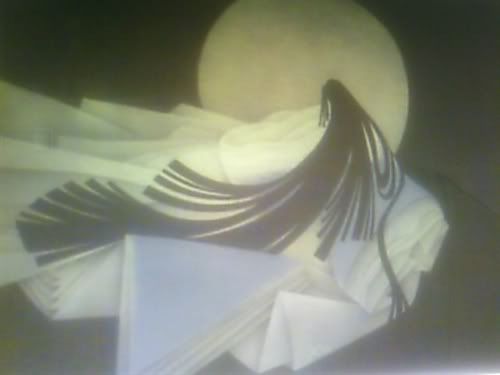
The sorrow of the bamboo cutter and the Emperor were overwhelming. Upon reading Kaguya's letter, the Emperor understood that she had loved him, but could not serve him as a wife, for she knew that she would have to leave. The Elixir was a gift, enabling him to live forever. "Why should I want to live forever, without her?" the Emperor asked. He demanded of his adviser, where in Japan is the closest to Heaven? The man told the Emperor of the highest mountain in the country, located in Suruga Province.
Now there are two different endings to this story. The first is that he instructed the leader of his guards to take the letter and Elixir to the mountain, and burn it. When all of the wealthy soldiers ascended the peak, the mountain came to be known as Fuji.
The Emperor went to that mountain, and as he scaled it he saw that at the peak was a pool with an island in the center, which had a palace. As he walked through the mist, however, he saw that it was only an illusion. He took the box with Kaguya's letter and the Elixir, pressed it to his chest, and killed himself. It is said that the flames of his love for Kaguya caused the mountain to erupt with ash and fire. And because of the Elixir, the mountain was known as Fushi, later Fuji, meaning "Immortality". And if enough people go to the top of the mountain, write a wish about love on a slip of paper, and put it in the smoke of the mountain, Mount Fuji will erupt again, and the ashes of that Emperor will shoot towards Heaven and mingle in the clouds, where he will reunite with Kaguya.

The End
In exciting news, Studio Ghibli has announced that they will make a film adaptation of this folktale! I for one am looking very forward to it, and am interested to see how they will interpret the story. I hope you will go see it, too. Who knows, it may be out by the time you finish reading this entry. Ah, and that was the trimmed-down version. Tomorrow's will be much shorter, I promise!
No comments:
Post a Comment